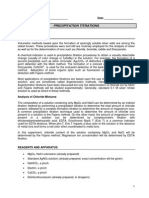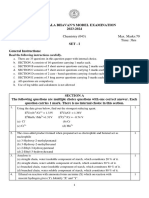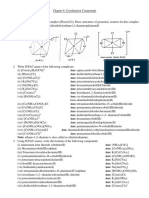Experiment 6
Experiment 6
Uploaded by
Joao DinizCopyright:
Available Formats
Experiment 6
Experiment 6
Uploaded by
Joao DinizCopyright
Available Formats
Share this document
Did you find this document useful?
Is this content inappropriate?
Copyright:
Available Formats
Experiment 6
Experiment 6
Uploaded by
Joao DinizCopyright:
Available Formats
Experiment 6 Deduction of a Spectrochemical Series from Octahedral Chromium(III) Complexes
Spectrochemical Series - 1
EXPERIMENT 6: Deduction of a Spectrochemical Series from Octahedral Chromium(III) Complexes
Aims to prepare (pseudo) octahedral complexes of chromium(III) to measure their solution UV-visible spectra to construct a spectrochemical series for the ligands utilised Introduction The simplest experimental illustration of the spectrochemical series should be the spectroscopic investigation of octahedral or tetrahedral complexes of d 1 or d9 ions, where a single spectral transition, of energy 10 Dq, is predicted. There are, however problems for both cases. The octahedral complexes of Ti(III) (d 1)are highly sensitive to air oxidation and a study of their spectra necessitates the use of inert atmosphere techniques for preparation and handling. The complexes of Cu(II) (d 9) generally deviate from either octahedral or tetrahedral symmetry. A good compromise between experimental simplicity and easy spectroscopic analysis exists in the case of Cr(III) complexes. Crystal field theory predicts that the 4F ground state of the free chromium ion is split into three levels as shown below:
4P
4T 1g
4T 1g 4F 4T 2g 4A 2g
The energy separation between the two lower levels, 4A2g and 4T2g is 10 Dq. Thus in the Cr(III) case, although we expect to find a more complicated spectrum than in the case of d 1 or d9 complexes, the energy of the longest wavelength peak gives the crystal field parameter 10 Dq. Experimental a) Preparation of [Cr(en)3]Cl3 - Wash 0.5-1.0 g of zinc granules with 6M HCl (to remove surface ZnO), - Place the zinc granules in a flask with CrCl 3.6H2O (2.66 g) and add ethylenediamine (10 cm3) and methanol (10 cm 3). - Reflux for 1 hour. - Cool the solution to room temperature. - Collect the yellow product (contaminated with a black solid) by filtration. - Wash with 10% ethylenediamine in methanol until the washings are colourless. - Wash with a small portion of ether and suck air through the product until dry. - Recrystallise by dissolving in the minimum quantity of a 1:1 methanol/water mixture at 60C, filtering and cooling on an ice-salt bath to crystallise the product.
Spectrochemical Series - 2
The temperature is critical in this process, since above 60 C the complex decomposes to a deep red solution. - Record the yield (g, %). If your product does not precipitate, take 1 cm 3 of the yellow solution and retain (for running a UV-visible spectrum if no solid is obtained). Treat the remaining solution with MeOH and cool again yellow solid should now appear.
b) Preparation of K3[Cr(ox)3] - Dissolve oxalic acid dihydrate (4.5 g) in distilled water (10 cm 3) with gentle warming. - While the solution is still warm add potassium dichromate (1.5 g) in small portions. - After the vigorous reaction has subsided, heat gently to boiling and add potassium oxalate (1.8 g). - When the potassium oxalate has dissolved allow the solution to cool to room temperature. - Add ethanol (3 cm 3) and cool on an ice bath. Blue-black crystals should separate. - Filter, wash first with ethanol/water (1:1 V/V, 50 cm 3) and then with pure ethanol (25 cm 3) and air dry. - Record the yield (g, %). c) Preparation of [Cr(acac)3] - Dissolve CrCl3.6H2O (2 g) in water (40 cm 3) and add urea (10 g) and acetylacetone (8 cm 3). - Heat the mixture on a water bath for 1 - 2 hours. Deep maroon crystals should form. - Cool the flask to room temperature. - Collect the product by filtration, wash with water and air dry. - Record the yield (g, %). - Determine the melting point of your product. Spectra - Using small graduated flasks, accurately prepare solutions of the four compounds below at the concentrations indicated. The concentrations given are only a guide and you may require to dilute some of them in order to get the absorbance on scale. 1. 2. 3. 4. [Cr(OH2)6] (NO3)3.3H2O [Cr(en)3]Cl3.2H2O K3[Cr(ox) 3] [Cr(acac)3] 0.04 M in 0.04 M in 0.01 M in 0.01 M in water water water CHCl3.
- Run the UV-visible spectrum of each solution. Questions 1. 2. 3. 4. Why is zinc used in the preparation of [Cr(en) 3]Cl3? In the preparation of K 3[Cr(ox)3], how is Cr(VI) in the dichromate starting material reduced to chromium(III) in the product? Write balanced redox equations for the process. What is the spectrochemical series? From the positions of the lowest energy (highest wavelength) absorption maxima in the UV-visible spectra obtain values of 10 Dq (in cm -1) for each species.
Spectrochemical Series - 3
The energy of the absorption in cm -1 is given by the following expression E (cm -1) = 107 / (nm) and the molar absorptivity is given by Beers Law: A = cl A = absorbance = molar absorptivity (dm 3 mol-1 cm-1) c = concentration (mol dm -3) l = pathlength (cm)
4.
Derive a spectrochemical series for the ligands involved.
Spectrochemical Series - 4
You might also like
- S.6 Chemistry of Aluminium, Group IV Group VIIDocument78 pagesS.6 Chemistry of Aluminium, Group IV Group VIIABEL JEDIDIAHNo ratings yet
- CHEM F111 - General Chemistry - I Sem 2022-2023 HODocument2 pagesCHEM F111 - General Chemistry - I Sem 2022-2023 HOjohn doeNo ratings yet
- 8 - Lab8-Potentiometric Titration of Acid MixtureDocument6 pages8 - Lab8-Potentiometric Titration of Acid MixtureHoang Huong TraNo ratings yet
- Post Lab 8 - Chem 8Document3 pagesPost Lab 8 - Chem 8Christi ViajeNo ratings yet
- Exp 2 Redox Inorganic ChemistryDocument11 pagesExp 2 Redox Inorganic ChemistryAhmad Rawi100% (1)
- Organi Chem 220709 FINALDocument159 pagesOrgani Chem 220709 FINALMuhammad Abdur RokhimNo ratings yet
- Inorganic Chemistry - VBT and CFT and MOT TheoriesDocument19 pagesInorganic Chemistry - VBT and CFT and MOT TheoriesHazhir Ismael100% (3)
- Synthesis of Cobalt ComplexDocument6 pagesSynthesis of Cobalt ComplexRenniel Pena100% (1)
- M-M Bonds and Cluster ChemistryDocument136 pagesM-M Bonds and Cluster ChemistryrisfiNo ratings yet
- Preparation of The Paramagnetic Complex MNDocument6 pagesPreparation of The Paramagnetic Complex MNCheyenne MartinsNo ratings yet
- Nptel: Technology of Surface Coating - Video CourseDocument3 pagesNptel: Technology of Surface Coating - Video CourseRajeev vermaNo ratings yet
- Preparation of Tin TetraiodideDocument2 pagesPreparation of Tin Tetraiodidestudent_4_evaNo ratings yet
- Trans-Dichlorobis (Ethylenediamine) Cobalt (III) Chloride: The Synthesis ofDocument9 pagesTrans-Dichlorobis (Ethylenediamine) Cobalt (III) Chloride: The Synthesis ofANA MARIA VERA ESCAMILLANo ratings yet
- Lab Manual Metal Acetylacetonate Complexes Web PDFDocument22 pagesLab Manual Metal Acetylacetonate Complexes Web PDFYan Jie ChongNo ratings yet
- Acid-Catalyzed Dehydration of Cyclohexanol To Cyclohexene Lab - ReportDocument7 pagesAcid-Catalyzed Dehydration of Cyclohexanol To Cyclohexene Lab - ReportMcAdam TULAPI100% (1)
- Redox EquilibriaDocument2 pagesRedox Equilibriafunkykid80No ratings yet
- Equilibrium Electrode Potential: Nernst EquationDocument10 pagesEquilibrium Electrode Potential: Nernst EquationSmruthi SuvarnaNo ratings yet
- CUSO4 PostlabDocument8 pagesCUSO4 PostlabRuwanthika Fernando100% (1)
- Preperatory TechniquesDocument24 pagesPreperatory TechniquessundaasNo ratings yet
- Preparation of B-NaphtholDocument4 pagesPreparation of B-NaphtholnithansaNo ratings yet
- Lab Report 3Document9 pagesLab Report 3ainnor100% (1)
- Inorganic Prac 2Document3 pagesInorganic Prac 2Ray DyerNo ratings yet
- CHM 212 Experiment 5 - Gravimetric Determination of Calcium As ...Document2 pagesCHM 212 Experiment 5 - Gravimetric Determination of Calcium As ...Shante MorganNo ratings yet
- Buffer SolutionsDocument21 pagesBuffer SolutionsRizka Nur FaridaNo ratings yet
- Back TitrationDocument2 pagesBack TitrationjohnNo ratings yet
- Determination of Nickel As The Dimethylglyoxime Complex by SpectrophotometryDocument5 pagesDetermination of Nickel As The Dimethylglyoxime Complex by Spectrophotometryevenspase7859No ratings yet
- Liquid Liquid ExtractionDocument36 pagesLiquid Liquid ExtractionamirnimoNo ratings yet
- CHM 423 PDFDocument110 pagesCHM 423 PDFKokoh EmmanuelNo ratings yet
- Objectives: FIGURE A: Example of Coordination CompoundsDocument7 pagesObjectives: FIGURE A: Example of Coordination CompoundsNurul izzatiNo ratings yet
- Kwame Nkrumah University of Science and Technology: Glassware: A Statistical StudyDocument8 pagesKwame Nkrumah University of Science and Technology: Glassware: A Statistical StudyJIEHASMARTNo ratings yet
- Partially Miscible LiquidsDocument8 pagesPartially Miscible LiquidsRenz Roger Esteves Buendicho100% (1)
- Argento Me TryDocument5 pagesArgento Me TryGino GalanoNo ratings yet
- Anthranilic Acid PDFDocument20 pagesAnthranilic Acid PDFGlibNo ratings yet
- Cinetica Reaccion FeCl3 Con KIDocument8 pagesCinetica Reaccion FeCl3 Con KIAngie RiobambaNo ratings yet
- Adsorption IsothermDocument4 pagesAdsorption Isothermahkiujtsw0% (1)
- TN680 MHTC 96 Drop CalorimetryDocument9 pagesTN680 MHTC 96 Drop CalorimetryMiruna PetriaNo ratings yet
- Benzoin Condensation.Document7 pagesBenzoin Condensation.Sam Bina92% (13)
- Revised Jobs MethodDocument5 pagesRevised Jobs Methodsilwadi71No ratings yet
- Sigmatropic Rearrangement ReactionDocument18 pagesSigmatropic Rearrangement ReactionSuman ChauhanNo ratings yet
- Physical ChemistryDocument7 pagesPhysical ChemistrySIDRA NAZEER SAIF100% (1)
- Adsorption EquilibriaDocument29 pagesAdsorption Equilibriamasruri123No ratings yet
- Beckmann Rearrangement Cyclohexanone Oxime and Its Rearrangement to Ε-CaprolactamDocument4 pagesBeckmann Rearrangement Cyclohexanone Oxime and Its Rearrangement to Ε-CaprolactamElif YeşilyaprakNo ratings yet
- Experiment - Determination of Angle of Rotation of A Sugar Solution. Organic Chemistry II Lab ManualDocument5 pagesExperiment - Determination of Angle of Rotation of A Sugar Solution. Organic Chemistry II Lab Manualusman1200550% (1)
- Laboratory Manual: SKT 1013 Introduction To Inorganic ChemistryDocument23 pagesLaboratory Manual: SKT 1013 Introduction To Inorganic Chemistryizz isalahNo ratings yet
- 15 Multistep Synthesis Synthons DisconDocument38 pages15 Multistep Synthesis Synthons DisconGowtham LecturesNo ratings yet
- Electron Transfer in BiologyDocument20 pagesElectron Transfer in BiologyVani KaushikNo ratings yet
- Separation and Identification of CationsDocument6 pagesSeparation and Identification of CationsJoseph Pelaelo100% (1)
- ADSORPTIONDocument6 pagesADSORPTIONSatyamGupta0% (1)
- Chapter 16 ADocument30 pagesChapter 16 AAbhishek Isaac MathewNo ratings yet
- Experiment 2: StoichiometryDocument9 pagesExperiment 2: StoichiometryNURFASYA ATIKA BINTI ROSLI / UPMNo ratings yet
- Absorption Spectrum of A Conjugated DyeDocument6 pagesAbsorption Spectrum of A Conjugated DyeKing Everest100% (1)
- The Fluoride Ion Selective Electrode ExperimentDocument5 pagesThe Fluoride Ion Selective Electrode Experimentlisaaliyo0% (1)
- CH425Document35 pagesCH425Vatra ReksaNo ratings yet
- Experiments 3,4,5Document13 pagesExperiments 3,4,5Athirah JamalludinNo ratings yet
- Spectrophotometric Determination of The Equilibrium Constant of A Reaction Chem 17Document7 pagesSpectrophotometric Determination of The Equilibrium Constant of A Reaction Chem 17Frances Abegail QuezonNo ratings yet
- A.1. Models of The Electrical Double LayerDocument14 pagesA.1. Models of The Electrical Double LayerCambiado ElnombreNo ratings yet
- Experiment 4 - Conductometry PDFDocument18 pagesExperiment 4 - Conductometry PDFWANGNo ratings yet
- Organometallic Transition Metal Catalysis: A Holistic Approach to Understanding and Predicting their MechanismsFrom EverandOrganometallic Transition Metal Catalysis: A Holistic Approach to Understanding and Predicting their MechanismsNo ratings yet
- Chemical Reaction Kinetics: Concepts, Methods and Case StudiesFrom EverandChemical Reaction Kinetics: Concepts, Methods and Case StudiesNo ratings yet
- 152 C 20 NewDocument37 pages152 C 20 NewGaotingweNo ratings yet
- ChemistryDocument7 pagesChemistryrjakrithiNo ratings yet
- Jee Main 2019 Jan ChemDocument84 pagesJee Main 2019 Jan ChemBhavesh KriplaniNo ratings yet
- WebM-L and M-M Bonding 2011-12Document40 pagesWebM-L and M-M Bonding 2011-12rafelNo ratings yet
- Chemistry Module 2 Part 2Document60 pagesChemistry Module 2 Part 2RiyazNo ratings yet
- Chapter 5 - Coordination Compounds-1Document2 pagesChapter 5 - Coordination Compounds-1Roronoa ZoroNo ratings yet
- 12 Chemistry Impq CH07 The P Block Elements 03Document15 pages12 Chemistry Impq CH07 The P Block Elements 03Ricky SharmaNo ratings yet
- CY1001-2015 Inorganic Lecture NotesDocument16 pagesCY1001-2015 Inorganic Lecture NotesCreative ThinkerNo ratings yet
- Unit 9 Coordination QN BankDocument6 pagesUnit 9 Coordination QN BankDharaneesh S.k.No ratings yet
- NCERT Solutions Class 12 Chemistry Chapter 9 Coordination CompoundsDocument21 pagesNCERT Solutions Class 12 Chemistry Chapter 9 Coordination CompoundsVidyakulNo ratings yet
- Exam Try Inor - PrintDocument6 pagesExam Try Inor - PrintHà Thế VinhNo ratings yet
- Complex Ions and Coordination Compounds: Practice ExamplesDocument17 pagesComplex Ions and Coordination Compounds: Practice Exampleskennethleo69No ratings yet
- MOT-Tetrahed-Square-Planar (Sima & Pie)Document12 pagesMOT-Tetrahed-Square-Planar (Sima & Pie)Sourav SenapatiNo ratings yet
- Cocomp. (Repaired)Document20 pagesCocomp. (Repaired)Vinod ChaudhariNo ratings yet
- MSC Chemistry SyllabusDocument25 pagesMSC Chemistry SyllabusSathish Kumar KurapatiNo ratings yet
- SeminarDocument23 pagesSeminarAditya SharmaNo ratings yet
- Coordination CompoundsDocument16 pagesCoordination CompoundsAdi Keni67% (3)
- 2021 SEM 4 CC8 InorganicDocument4 pages2021 SEM 4 CC8 InorganicGaurav KumarNo ratings yet
- M.SC Chemistry SyallabusDocument78 pagesM.SC Chemistry SyallabusSaimeen SayeedNo ratings yet
- Coordination DPPendgameDocument15 pagesCoordination DPPendgameSaronik PalNo ratings yet
- Nonmetals and Metalloids: Examples of Multiple Choice QuestionsDocument20 pagesNonmetals and Metalloids: Examples of Multiple Choice Questionsngah lidwineNo ratings yet
- Fred Basolo - Ronald C. Johnson-Coordination Chemistry-Science Reviews (1986) PDFDocument148 pagesFred Basolo - Ronald C. Johnson-Coordination Chemistry-Science Reviews (1986) PDFbrunoespostoNo ratings yet
- Model Question Paper - ChemistrydocumentDocument7 pagesModel Question Paper - ChemistrydocumentHritik AgarwalNo ratings yet
- JD Lee.Document718 pagesJD Lee.mekom97941100% (1)
- Coordination Chemistry PDFDocument4 pagesCoordination Chemistry PDFBudhaditya BanerjeeNo ratings yet
- Crystal Field Theory: Energies of The D OrbitalsDocument65 pagesCrystal Field Theory: Energies of The D OrbitalsNov IndaNo ratings yet
- Valence Bond Theory For Complexes: Presentation OutlineDocument6 pagesValence Bond Theory For Complexes: Presentation OutlineNurul Izzah KaharNo ratings yet
- Lecture 9Document30 pagesLecture 9JetNoKunNo ratings yet

























































































